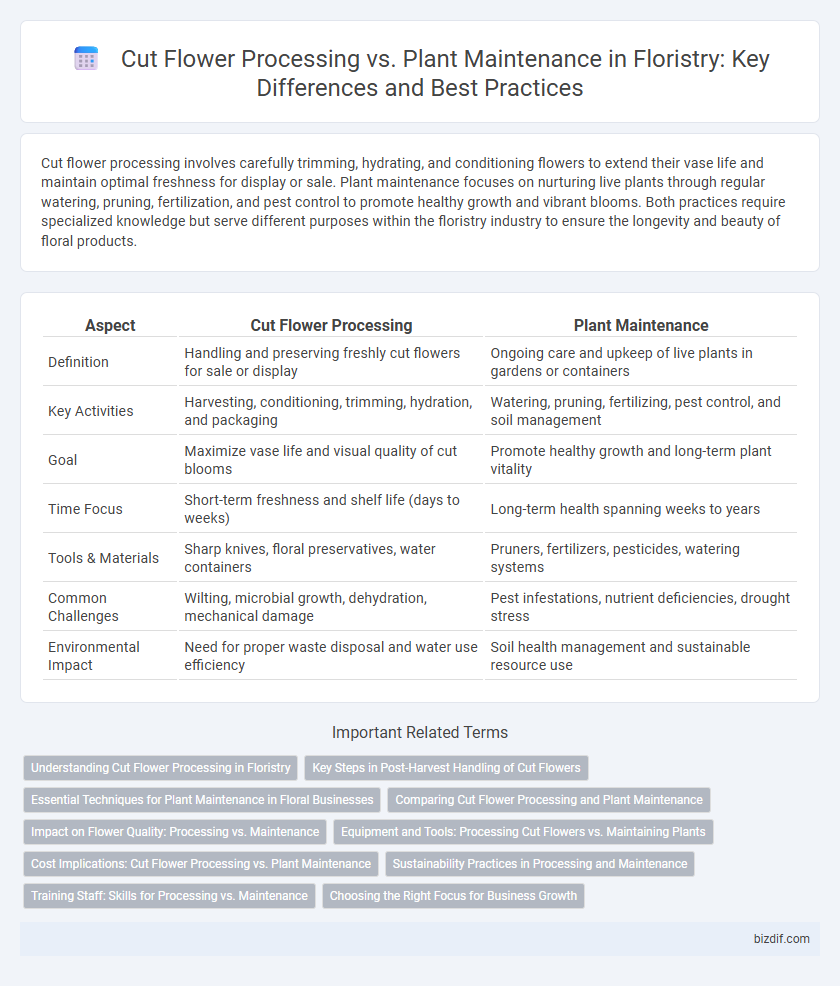Cut flower processing involves carefully trimming, hydrating, and conditioning flowers to extend their vase life and maintain optimal freshness for display or sale. Plant maintenance focuses on nurturing live plants through regular watering, pruning, fertilization, and pest control to promote healthy growth and vibrant blooms. Both practices require specialized knowledge but serve different purposes within the floristry industry to ensure the longevity and beauty of floral products.
Table of Comparison
| Aspect | Cut Flower Processing | Plant Maintenance |
|---|---|---|
| Definition | Handling and preserving freshly cut flowers for sale or display | Ongoing care and upkeep of live plants in gardens or containers |
| Key Activities | Harvesting, conditioning, trimming, hydration, and packaging | Watering, pruning, fertilizing, pest control, and soil management |
| Goal | Maximize vase life and visual quality of cut blooms | Promote healthy growth and long-term plant vitality |
| Time Focus | Short-term freshness and shelf life (days to weeks) | Long-term health spanning weeks to years |
| Tools & Materials | Sharp knives, floral preservatives, water containers | Pruners, fertilizers, pesticides, watering systems |
| Common Challenges | Wilting, microbial growth, dehydration, mechanical damage | Pest infestations, nutrient deficiencies, drought stress |
| Environmental Impact | Need for proper waste disposal and water use efficiency | Soil health management and sustainable resource use |
Understanding Cut Flower Processing in Floristry
Cut flower processing in floristry involves precise steps such as trimming stems, removing foliage below the waterline, and hydrating flowers to extend vase life and maintain optimal freshness. This process optimizes water uptake and reduces microbial growth, directly impacting the quality and longevity of floral arrangements. Unlike ongoing plant maintenance, cut flower processing is a focused preparation phase critical to successful floristry and retail display.
Key Steps in Post-Harvest Handling of Cut Flowers
Key steps in post-harvest handling of cut flowers include immediate hydration in clean, lukewarm water with floral preservatives to extend vase life and prevent bacterial growth. Proper stem recutting under water and temperature control during storage are essential to maintain freshness and reduce respiration rates. Avoiding physical damage and ensuring optimal humidity levels further enhance flower quality compared to ongoing plant maintenance practices.
Essential Techniques for Plant Maintenance in Floral Businesses
Essential techniques for plant maintenance in floral businesses include regular pruning, proper watering, and nutrient management to ensure healthy growth and prolonged plant vitality. Optimizing environmental conditions such as light, temperature, and humidity directly impacts plant resilience and flowering quality. Implementing integrated pest management strategies minimizes damage and supports sustainable floral production.
Comparing Cut Flower Processing and Plant Maintenance
Cut flower processing involves harvesting, conditioning, and preserving flowers to extend vase life, emphasizing techniques like hydration, temperature control, and proper packaging for optimal freshness. In contrast, plant maintenance focuses on ongoing care practices such as watering, pruning, fertilizing, and pest management to support the growth and health of living plants in their natural or cultivated environment. Both disciplines require knowledge of botanical characteristics, but cut flower processing prioritizes post-harvest longevity, while plant maintenance centers on sustaining growth and vitality over time.
Impact on Flower Quality: Processing vs. Maintenance
Cut flower processing involves precise techniques like trimming stems underwater and applying floral preservatives to extend vase life, significantly enhancing flower quality and longevity. In contrast, plant maintenance focuses on healthy cultivation practices such as proper watering, fertilization, and pest management, ensuring robust growth and optimal bloom development before harvesting. While processing directly affects the post-harvest lifespan and visual appeal, maintenance is crucial for producing high-quality blooms with strong stems and vibrant colors essential for superior cut flower quality.
Equipment and Tools: Processing Cut Flowers vs. Maintaining Plants
Cut flower processing requires specialized tools such as sharp floral shears, conditioning buckets, and wet foam to ensure freshness and longevity of blooms, while maintaining plants involves equipment like pruners, watering systems, and soil aerators for healthy growth. Processing tools focus on enhancing vase life and aesthetic appeal, whereas maintenance tools aim at supporting plant health and structural integrity. Both sets of equipment are essential for florists to deliver quality products but serve distinct purposes within plant care and floral arrangement workflows.
Cost Implications: Cut Flower Processing vs. Plant Maintenance
Cut flower processing entails significant expenses such as labor for harvesting, floral foam, preservatives, refrigeration, and transportation, leading to higher overall costs compared to plant maintenance. Plant maintenance involves ongoing investments in soil conditioning, irrigation, pest control, and regular pruning, which are generally lower but continuous over time. Evaluating cost implications reveals that cut flower processing demands intensive upfront expenditures, whereas plant maintenance requires steady, long-term financial commitment.
Sustainability Practices in Processing and Maintenance
Cut flower processing emphasizes sustainable practices such as using biodegradable floral foam alternatives and minimizing water waste through recirculation systems, which reduce environmental impact. Plant maintenance in floristry prioritizes organic fertilization and integrated pest management techniques that promote soil health and biodiversity. Both approaches contribute to sustainability by lowering carbon footprints and enhancing resource efficiency in floral production.
Training Staff: Skills for Processing vs. Maintenance
Training staff in cut flower processing emphasizes skills in selective harvesting, hydration techniques, and precise stem cutting to maximize vase life and flower quality. In contrast, plant maintenance training prioritizes expertise in pruning, pest management, and nutrient application to sustain plant health and growth. Developing these distinct sets of skills ensures operational efficiency and optimal floral product outcomes.
Choosing the Right Focus for Business Growth
Cut flower processing requires specialized handling techniques such as precise trimming, hydration, and temperature control to maximize vase life and market value. Plant maintenance focuses on soil health, pest management, and growth optimization to ensure long-term plant vitality and production. Selecting the right focus depends on business goals: cut flower processing suits fast turnover and retail markets, while plant maintenance complements sustainable cultivation and wholesale supply.
Cut flower processing vs Plant maintenance Infographic

 bizdif.com
bizdif.com